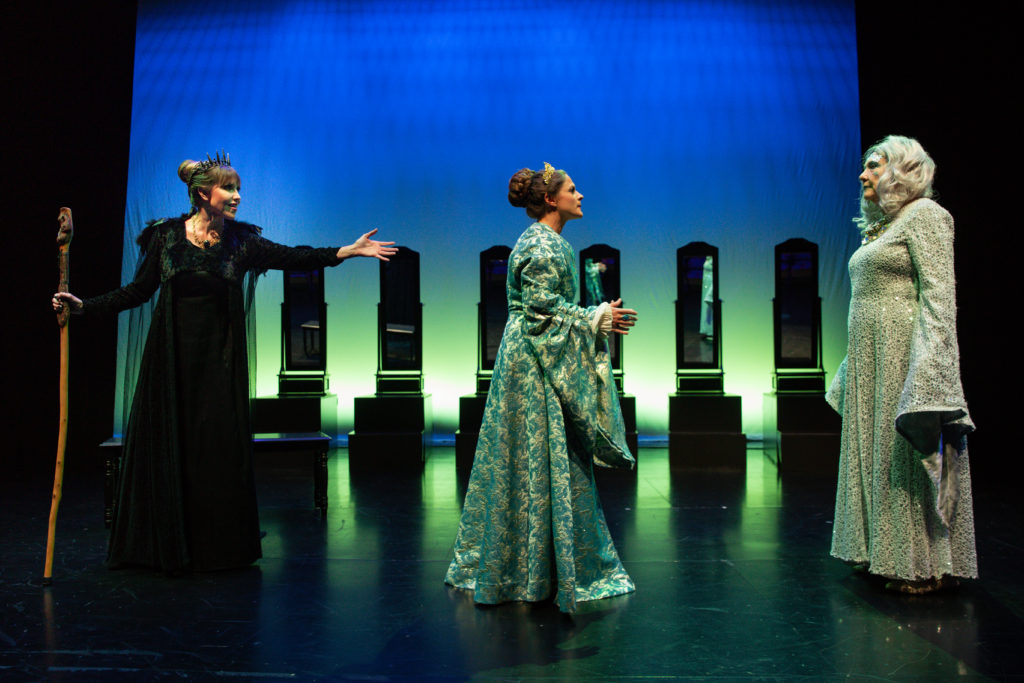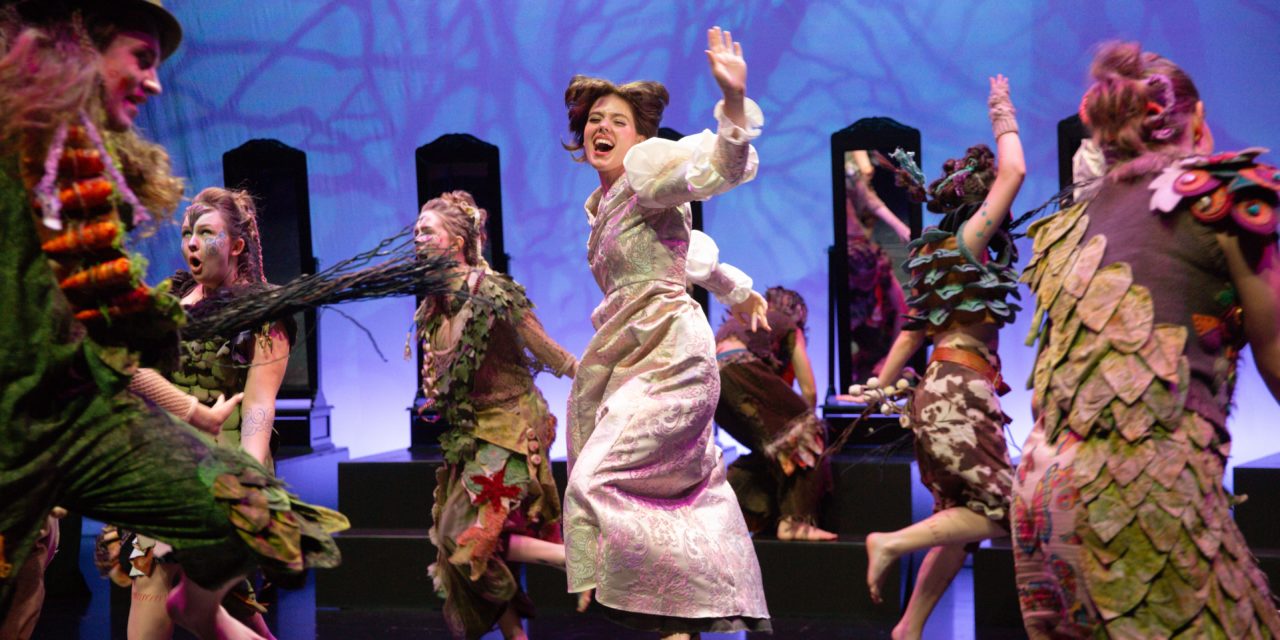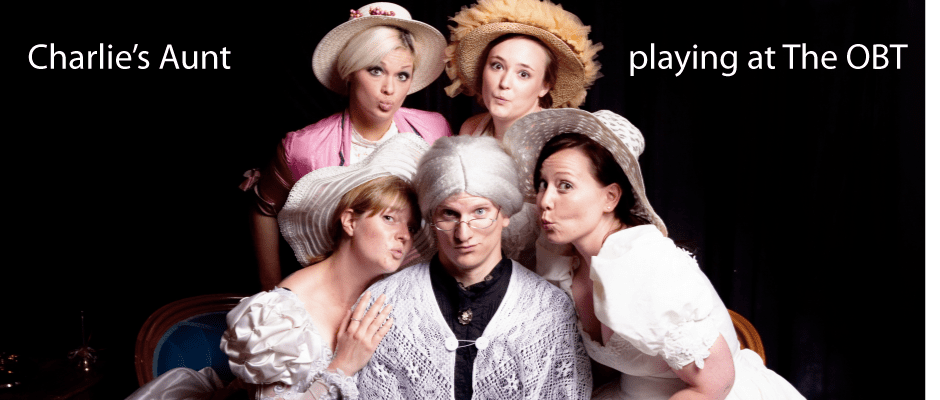SALT LAKE CITY — Walking into the Regent Street Black Box theatre, patrons are presented with a sparse stage intriguingly lined by seven mirrors atop seven boxes. The mirrors evoke a sense of introspection as the audience waits for what the program promises will be a Satyr Play, the classical Greek (and original) form of tragicomedy. A read through the director’s note is very informative–unsurprising given the director, and playwright Javen Tanner, is a high school teacher. But the note reads like a theatre history lesson more than an invitation into the world of the play. Though admittedly the lesson is very helpful in understanding the conventions and framework of the production.

Show closes July 29, 2023.
From the moment the entire cast, like a classical Greek chorus, steps onto the stage to deliver a prologue in song, it is apparent that we have entered a world that, much like the name Sting and Honey, strives to simultaneously blend and juxtapose both the classic and the modern, magic and reality, tragedy and comedy. The final verse repeats and threads itself throughout the production, setting the tone and inviting the audience to some degree of introspection with the lines “Mirror, Mirror, on the wall, Who will Rise? Who will fall? Which are friends? Which are foes? Only your reflection knows.” The music itself is pleasant and inviting and having the entire cast participate prepares the audience with a visual overview of the production at hand.
The end of the prologue introduces the lovely young Eirwen, or Snow White, played by Rain Flower Tanner. Tanner’s portrayal of the princess is sweet and earnest and she looks the part, yet the character has an almost affected and childlike timidity. Had this transitioned over the course of the play into a more mature and confident young woman, it would tell a more convincing story of transformation. But as the characterization and vocal affectation persists throughout the production, it serves as a distraction that works against her character arc. The director’s note describes the journey of Snow White as that of a lost girl who leaves the safety and structure of her home and “faces trials” and “transcends dread” as part of a transformative journey. Yet Tanner’s delicate portrayal of the princess from beginning to end was a missed opportunity for the director to create a more dynamic transformation from a naïve child to a bold young adult.
Cherie Gallian’s costume design does somewhat mitigate the production’s miss in the transformation of Snow White. The costuming allows Snow to visually evolve, almost butterfly like, from the weighted cocoon of her palace gown to the light and leafy frock in which she later emerges from the forest. To the credit of Gallian and the production’s costume assistants Mia James and Ai Lee Woods, the costuming throughout is rich and visually delightful. The Mirror, played somewhat stiffly by Kathryn Atwood, shimmers in her bedazzled gown and is counterbalanced by the intricate black gown and cape worn by the evil Fand, played by Deena Marie Manzanares. Manzanares also looks the part of the evil witch but plays the role somewhat one-dimensionally with a great deal of campy cackling. However, the production’s visual standouts are the Seven Satyrs whose costuming and hair is wild, lush and evocative of the forest, of which they are a part.

Left to right: Deena Marie Manzanares as Fand, Susan Barry as Queen Olwen, and Kathryn Atwood as The Mirror.
The appearance of the Satyrs mid-way through the production was expected if you have read the program notes, otherwise you might be surprised at the complete absence of dwarves. As Tanner explains, though today’s audiences might be most familiar with dwarves as Snow White’s companions, various cultures have supplied her with others, even dragons. As such, Tanner takes the liberty of giving Snow a gaggle of Satyrs (not the man-goat version, but a man-horse-tree version), thus fulfilling the promise of a satyr play, and making me wish he’d also titled the show “Snow White and the Seven Satyrs” if only for the alliteration.
Tanner’s staging was as staid and prosaic in the first half of the production as it was delightful and captivating in the second. If Tanner was aiming for stark contrast in the staging, he achieved it, but at the cost of the palace scenes often dragging towards dullness. The verdant and wild tableaus created by the rambunctious satyrs are striking and these visual elements are some of the strongest of the production. The Satyrs add a needed bit of levity and serve as the “wild, messy, untamable” part of Snow’s journey as described in the director’s notes. Despite their lush costuming and movement, their unfortunate tendency towards prolonged screaming at an eardrum piercing pitch was jarring and interfered with, rather than contributed to the moment. Nonetheless, the Satyrs’ movement was well staged and they created striking tableaus as they became trees each night, and again as they stood guard over Snow’s sleeping form.
The upstage cyclorama is effectively used throughout the production with color and projection gobos that evoke at different times the snowy scene at the protagonist’s birth, a shattered mirror, and the warmth of the forest. There are also some performances worth noting. Jaiden Castleton’s Orion was earnest with good comic timing and he shows promise as a young actor. Perhaps my favorite of the entire cast though was The Sprite, delightfully played by a young Kehoe Brogna, who injects a healthy dose of comedy into this tragicomedy while only speaking a single word.
There are a number of engaging moments and exchanges of dialogue throughout the production, yet in many ways the script tends toward self-indulgence, as if trying too hard to evoke the ghosts of Shakespeare and the Greek masters rather than embracing its own unique ingenuity. The result is akin to seeing a tribute band in concert; it’s a fun evening, but leaves you longing for the original.
The script certainly has potential—if it can get out of its own way. The biggest hurdle the production faces is the meandering of the plot, which falls short of a tight structure with clear rising action, conflict and resolution, and spends time telling, rather than showing us the story. Key plot moments are therefore lost in both too little and too much action. For example, the mirror’s capture of Snow White’s mother and her subsequent break out are both handled with awkward blackouts that left me trying to figure out what happened and how. Similarly, there is a chaotic moment at the climax, where the sequence of events is so muddied by a prolonged battle scene that I was left thoroughly confused as to how and when Snow White was released from her poisoned slumber—which is an important plot point to get right. With a bit of tightening of the script, some focus on structure, and clear visual storytelling applied to key plot points, it could have been magical.
At the end we are graced with a musical epilogue, a reprise of the prologue, wrapping the production together with a neat bow, which would have been a solid way to close. But alas, there was still a second and entirely gratuitous epilogue, given by Snow White herself, in an odd channeling of Shakespeare’s mischievous Puck of A Midsummer Night’s Dream renown. This unnecessary second epilogue seems to serve little purpose other than as a highbrow nod to the great Bard.
In the end, the words of the penitent King Hyperion, well played by Bijan Hosseini, stuck in my mind. He tells his queen “Your gracious magic moves a graceless King.” I wished in vain that the gracious magic of this production could have moved me more—I wanted to really love it and get caught up in its magic, but I didn’t, at least not completely. It is worth seeing though, if you are willing to give it a little grace for its faults. It has some clever and captivating elements from dancing satyrs to a giant boar puppet. I may not have been fully entranced, but I did enjoy it, in spite of its tendency to take itself too seriously.
Having seen this and other productions directed by Tanner, including Sting and Honey’s stellar production of Waiting for Godot in 2021, it is clear that Tanner is a talented director and actor. However, as a playwright, Snow White is evidence that he still has room for growth. Although knowing that Snow White was originally written and produced five years ago, perhaps the weaknesses in the script are attributable to a younger playwright. Nonetheless, having written the line delivered by his character Fand: “what hubris, to imagine you’ve got it all figured out,” I trust he recognizes he doesn’t yet have it all figured out and will continue to bring new and increasingly delightful original and classic works to the stage.





